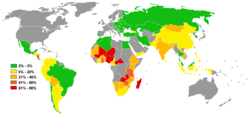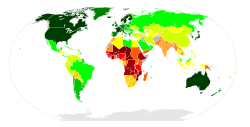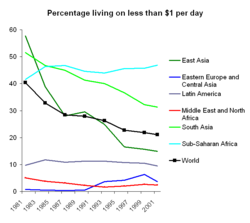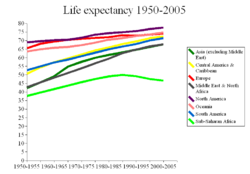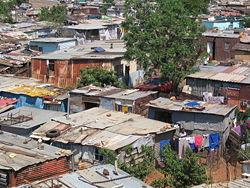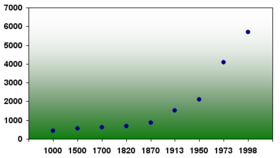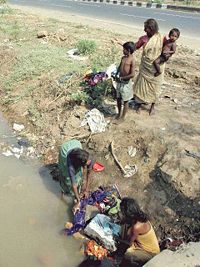Poverty
2008/9 Schools Wikipedia Selection. Related subjects: Animal & Human Rights; Culture and Diversity
Poverty is the condition of lacking full economic access to fundamental human needs such as food, shelter and safe drinking water. While some define poverty primarily in economic terms, others consider social and political arrangements to be intrinsic. Causes, effects, and measurement of poverty directly influences the design and implementation of poverty reduction programs, and is thus important to the fields of international development and public administration. Although poverty is generally considered to be undesirable, because of the pain and suffering that may accompany it, in certain spiritual contexts, it may be seen as a virtue because voluntary poverty involves the renunciation of material goods.
Poverty is a condition which may affect individuals or collective groups, and is not confined to the developing nations. In some developed countries, examples include homelessness and ghettos.
The book "The World Bank" by David Moore argues that some analyses of poverty reflect pejorative and sometimes racialized stereotypes of impoverished people as powerless victims, and passive recipients of aid programs.
Measuring poverty
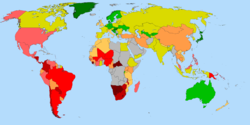
When measured, poverty may be absolute or relative poverty. Absolute poverty refers to a set standard which is consistent over time and between countries. An example of an absolute measurement would be the percentage of the population eating less food than is required to sustain the human body (approximately 2000-2500 calories per day for an adult male).
Economic aspects of poverty may focus on material needs, typically including the necessities of daily living, such as food, clothing, shelter, or safe drinking water. Poverty in this sense may be understood as a condition in which a person or community is deprived of the basic needs for a minimum standard of well-being and life, particularly as a result of a persistent lack of wealth and income, or wealth and income disparities.
Analysis of social aspects of poverty links conditions of scarcity to aspects of the distribution of resources and power in a society and recognizes that poverty may be a function of the diminished "capability" of people to live the kinds of lives they value. The social aspects of poverty may include lack of access to information, education, health care, or political power. Poverty may also be understood as an aspect of unequal social status and inequitable social relationships, experienced as social exclusion, dependency, and diminished capacity to participate, or to develop meaningful connections with other people in society.
The World Bank's "Voices of the Poor," based on research with over 20,000 poor people in 23 countries, identifies a range of factors which poor people identify as part of poverty. These include:
- precarious livelihoods
- excluded locations
- physical limitations
- gender relationships
- problems in social relationships
- lack of security
- abuse by those in power
- disempowering institutions
- limited capabilities, and
- weak community organizations.
The World Bank defines extreme poverty as living on less than US$ ( PPP) 1 per day, and moderate poverty as less than $2 a day, estimating that "in 2001, 1.1 billion people had consumption levels below $1 a day and 2.7 billion lived on less than $2 a day." The proportion of the developing world's population living in extreme economic poverty fell from 28 percent in 1990 to 21 percent in 2001. Looking at the period 1981-2001, the percentage of the world's population living on less than $1 per day has halved.
However, most of this improvement has occurred in East and South Asia. In East Asia the World Bank reports that "The poverty headcount rate at the $2-a-day level is estimated to have fallen to about 27 percent, down from 29.5 percent in 2006 and 69 percent in 1990."
In Sub-Saharan Africa GDP/capita shrank by 14 percent and extreme poverty increased from 41 percent in 1981 to 46 percent in 2001, increasing the number of people living in poverty from 231 million to 318 million.
Other regions have seen little change. In the early 1990s the transition economies of Eastern Europe and Central Asia experienced a sharp drop in income. Poverty rates rose to 6 percent at the end of the decade before beginning to recede.
World Bank data shows that the percentage of the population living in households with consumption or income per person below the poverty line has decreased in each region of the world since 1999:
| Region | 1990 | 2002 | 2004 |
|---|---|---|---|
| East Asia and Pacific | 15.40% | 12.33% | 9.07% |
| Europe and Central Asia | 3.60% | 1.28% | 0.95% |
| Latin America and the Caribbean | 9.62% | 9.08% | 8.64% |
| Middle East and North Africa | 2.08% | 1.69% | 1.47% |
| South Asia | 35.04% | 33.44% | 30.84% |
| Sub-Saharan Africa | 46.07% | 42.63% | 41.09% |
There are various criticisms of these measurements. Shaohua Chen and Martin Ravallion note that although "a clear trend decline in the percentage of people who are absolutely poor is evident, although with uneven progress across regions...the developing world outside China and India has seen little or no sustained progress in reducing the number of poor". However, since the world's population has increased, if instead looking at the percentage living on less than $1/day, and if excluding China and India, then this percentage has decreased from 31.35% to 20.70% between 1981 and 2004.
Other human development indicators are also improving. Life expectancy has greatly increased in the developing world since WWII and is starting to close the gap to the developed world where the improvement has been smaller. Even in Sub-Saharan Africa, the least developed region, life expectancy increased from 30 years before World War II to a peak of about 50 years before the HIV pandemic and other diseases started to force it down to the current level of 47 years. Child mortality has decreased in every developing region of the world. The proportion of the world's population living in countries where per-capita food supplies are less than 2,200 calories (9,200 kilojoules) per day decreased from 56% in the mid-1960s to below 10% by the 1990s. Between 1950 and 1999, global literacy increased from 52% to 81% of the world. Women made up much of the gap: Female literacy as a percentage of male literacy has increased from 59% in 1970 to 80% in 2000. The percentage of children not in the labor force has also risen to over 90% in 2000 from 76% in 1960. There are similar trends for electric power, cars, radios, and telephones per capita, as well as the proportion of the population with access to clean water.
Relative poverty views poverty as socially defined and dependent on social context. Income inequality is a relative measure of poverty. A relative measurement would be to compare the total wealth of the poorest one-third of the population with the total wealth of richest 1% of the population. There are several different income inequality metrics. One example is the Gini coefficient.
Income inequality for the world as a whole is diminishing. A 2002 study by Xavier Sala-i-Martin finds that this is driven mainly, but not fully, by the extraordinary growth rate of the incomes of the 1.2 billion Chinese citizens. However, unless Africa achieves economic growth, then China, India, the OECD and the rest of middle-income and rich countries will increase their relative advantage, and global inequality will rise.
The 2007 World Bank report "Global Economic Prospects" predicts that in 2030 the number living on less than the equivalent of $1 a day will fall by half, to about 550 million. An average resident of what we used to call the Third World will live about as well as do residents of the Czech or Slovak republics today. However, much of Africa will have difficulty keeping pace with the rest of the developing world and even if conditions there improve in absolute terms, the report warns, Africa in 2030 will be home to a larger proportion of the world's poorest people than it is today. However, economic growth has increased rapidly in Africa after the year 2000.
In many developed countries the official definition of poverty used for statistical purposes is based on relative income. As such many critics argue that poverty statistics measure inequality rather than material deprivation or hardship. For instance, according to the U.S. Census Bureau, 46% of those in "poverty" in the U.S. own their own home (with the average poor person's home having three bedrooms, with one and a half baths, and a garage). Furthermore, the measurements are usually based on a person's yearly income and frequently take no account of total wealth. The main poverty line used in the OECD and the European Union is based on "economic distance", a level of income set at 50% of the median household income. The US poverty line is more arbitrary. It was created in 1963-64 and was based on the dollar costs of the U.S. Department of Agriculture's "economy food plan" multiplied by a factor of three. The multiplier was based on research showing that food costs then accounted for about one third of the total money income. This one-time calculation has since been annually updated for inflation.
Causes of poverty
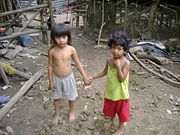
Many different factors have been cited to explain why poverty occurs. However, no single explanation has gained universal acceptance. At the international level some emphasise global systemic causes, (such as trade, aid and debt, the focus of the Make Poverty History campaign), while others point to national level deficiencies of public administration and financial management, the focus of the Good Governance agenda of the international financial institutions. At the national level, some point to personal factors, such as drug use, work ethic and education level as the main cause of poverty, while others indicate inadequate social services and policies biased in favour of the wealthy and social elite, as a cause of enduring poverty.
Other factors include:
Environmental Factors
- Intensive farming often leads to a vicious cycle of exhaustion of soil fertility and decline of agricultural yields and thence increased poverty.
- Deforestation as exemplified by the widespread rural poverty in China that began in the early 20th century and is attributed to non-sustainable tree harvesting.
- Natural factors such as the climate or environment
- Geographic factors, for example access to fertile land, fresh water, minerals, energy, and other natural resources. Presence or absence of natural features helping or limiting communication, such as mountains, deserts, sailable rivers, or coastline. Historically, geography has prevented or slowed the spread of new technology to areas such as the Americas and Sub-Saharan Africa. The climate also limits what crops and farm animals may be used on similarly fertile lands.
- On the other hand, research on the resource curse has found that countries with an abundance of natural resources creating quick wealth from exports tend to have less long-term prosperity than countries with less of these natural resources.
Economics
- In a wage-based economic system, lack of access to jobs at appropriately skilled levels can deprive individuals of essential income and undermine human dignity and sense of worth..
- Capital flight by which the wealthy in a society shift their assets to off-shore tax havens deprives nations of revenue needed to break the vicious cycle of poverty.
- Weakly entrenched formal systems of title to private property are seen by writers such as Hernando de Soto as a limit to economic growth and therefore a cause of poverty.
- Communists see the institution of property rights itself as a cause of poverty.
- Unfair terms of trade, in particular, the very high subsidies to and protective tariffs for agriculture in the developed world, is seen as a major cause of enduring poverty in developing countries heavily reliant on commodity exports.
- Low wages can undermine the ability of households to save and thus make them less resilient to shocks in the economy and more vulnerable to poverty.
Health Care
- Poor access to affordable health care makes individuals less resilient to economic hardship and more vulnerable to poverty.
- Inadequate nutrition in childhood, itself an effect of poverty, undermines the ability of individuals to develop their full human capabilities and thus makes them more vulnerable to poverty. Lack of essential minerals such as iodine and iron can impair brain development. It is estimated that 2 billion people (one-third of the total global population) are affected by iodine deficiency, including 285 million 6- to 12-year-old children. In developing countries, it is estimated that 40% of children aged 4 and under suffer from anaemia because of insufficient iron in their diets. See also Health and intelligence.
- Disease, specifically diseases of poverty: AIDS, malaria, and tuberculosis and others overwhelmingly afflict developing nations, which perpetuate poverty by diverting individual, community, and national health and economic resources from investment and productivity. Further, many tropical nations are affected by parasites like malaria, schistosomiasis, and trypanosomiasis that are not present in temperate climates. The Tsetse fly makes it very difficult to use many animals in agriculture in afflicted regions.
- Clinical depression undermines the resilience of individuals and when not properly treated makes them vulnerable to poverty.
- Similarly substance abuse, including for example alcoholism and drug abuse when not properly treated undermines resilience and can consign people to vicious poverty cycles.
Governance
- the governance effectiveness of governments has a major impact on the delivery of socioeconomic outcomes for poor populations
- Weak rule of law can discourage investment and thus perpetuate poverty.
- Poor management of resource revenues can mean that rather than lifting countries out of poverty, revenues from such activities as oil production or gold mining actually leads to a resource curse.
- Failure by governments to provide essential infrastructure worsens poverty..
- Poor access to affordable education traps individuals and countries in cycles of poverty.
- High levels of corruption undermine efforts to make a sustainable impact on poverty. In Nigeria, for example, more than $400 billion was stolen from the treasury by Nigeria's leaders between 1960 and 1999.
Demographics and Social Factors
- Overpopulation and lack of access to birth control methods. Note that population growth slows or even become negative as poverty is reduced due to the demographic transition.
- Crime, both white-collar crime and blue-collar crime.
- Historical factors, for example imperialism and colonialism
- Brain drain
- Matthew effect: the phenomenon, widely observed across advanced welfare states, that the middle classes tend to be the main beneficiaries of social benefits and services, even if these are primarily targeted at the poor.
- Cultural causes, which attribute poverty to common patterns of life, learned or shared within a community. For example, Max Weber argued that the Protestant work ethic contributed to economic growth during the industrial revolution.
- War, including civil war, genocide, and democide.
- Discrimination of various kinds, such as age discrimination, stereotyping, gender discrimination, racial discrimination, caste discrimination.
- Individual beliefs, actions and choices.
Effects of poverty
Some effects of poverty may also be causes, as listed above, thus creating a " poverty cycle" operating across multiple levels, individual, local, national and global.
Those living in poverty and lacking access to essential health services, suffering hunger or even starvation, experience mental and physical health problems which make it harder for them to improve their situation. One third of deaths - some 18 million people a year or 50,000 per day - are due to poverty-related causes: in total 270 million people, most of them women and children, have died as a result of poverty since 1990. Those living in poverty suffer lower life expectancy. Every year nearly 11 million children living in poverty die before their fifth birthday. Those living in poverty often suffer from hunger. 800 million people go to bed hungry every night. Poverty increases the risk of homelessness. Increased risk of drug abuse may also be associated with poverty.
Those living in poverty may suffer social isolation and rates of suicide may increase in conditions of poverty. Death of a breadwinner may decrease a household's resilience to poverty conditions and cause a dramatic worsening in their situation. Low income levels and poor employent opportunities for adults in turn create the conditions where households can depend on the income of child members. An estimated 218 million children aged 5 to 17 are in child labor worldwide, excluding child domestic labor. Lacking viable employment opportunities those living in poverty may also engage in the informal economy, or in criminal activity, both of which may on a larger scale discourage investment in the economy, further perpetuating conditions of poverty.
Low income and wealth levels undermine the ability of governments to levy taxes for public service provision, adding to the 'vicious circle' connecting the causes and effects of poverty. Lack of essential infrastructure, poor education and health services, and poor sanitation contribute to the perpetuation of poverty. Poor access to affordable public education can lead to low levels of literacy, further entrenching poverty. Weak public service provision and high levels of poverty can increase states' vulnerability to natural disasters and make states more vulnerable to shocks in the international economy, such as those associated with rising fuel prices, or declining commodity prices.
The capacity of the state is further undermined by the problem that people living in poverty may be more vulnerable to extremist political persuasion, and may feel less loyalty to a state unable to deliver basic services. For these reasons conditions of poverty may increase the risk of political violence, terrorism, war and genocide, and may make those living in poverty vulnerable to human trafficking, internal displacement and exile as refugees. Countries suffering widespread poverty may experience loss of population, particularly in high-skilled professions, through emigration, which may further undermine their ability to improve their situation.
Poverty reduction
In politics, the fight against poverty is usually regarded as a social goal and many governments have institutions or departments dedicated to tackling poverty. One of the main debates in the field of poverty reduction is around the question of how actively the state should manage the economy and provide public services to tackle the problem of poverty. In the nineties, international development policies focused on a package of measures known as the Washington Consensus which involved reducing the scope of state activities, and reducing state intervention in the economy, reducing trade barriers and opening economies to foreign investment. In the current decade, the importance of strong and functioning states to poverty reduction is more widely recognised. Vigorous debate over these issues continues however, and most poverty reduction programs attempt to increase both the competitiveness of the economy and the viability of the state.
International economic policy
Free Trade
What could broadly be called free market reforms represent one strategy for reducing poverty. For example, noted reductions in poverty in the 20th century have been in India and China, where hundreds of millions of people in the two countries grew out of poverty, mostly as a result of the abandonment of collective farming in China and the cutting of government red tape in India. This was critical in fostering their dramatic economic growth. However, UN economists argue that for the market reforms to work, good infrastructure is needed, and for that the role of a strong state is important. For example, today, China is investing in railways, roads, ports and rural telephony in various African countries as part of its formula for economic development.
- The anti-poverty strategy of the World Bank depends heavily on reducing poverty through the promotion of economic growth. The World Bank argues that an overview of many studies shows that:
- Growth is fundamental for poverty reduction, and in principle growth as such does not affect inequality.
- Growth accompanied by progressive distributional change is better than growth alone.
- High initial income inequality is a brake on poverty reduction.
- Poverty itself is also likely to be a barrier for poverty reduction; and wealth inequality seems to predict lower future growth rates.
- The Global Competitiveness Report, the Ease of Doing Business Index, and the Index of Economic Freedom are annual reports, often used in academic research, ranking the worlds nations on factors argued to increase economic growth and reduce poverty.
- Business groups see the reduction of barriers to the creation of new businesses , or reducing barriers for existing business, as having the effect of bringing more people into the formal economy.
Fair Trade
Developing countries face a range of obstacles to trading competitively on international markets which are the focus of the 'fair trade' campaign associated with the global Make Poverty History campaign. Almost half of the budget of the European Union for example is directed to agricultural subsidies, which primarily benefit large multinational agribusinesses who form a powerful lobby. Japan gave 47 billion dollars in 2005 in subsidies to its agricultural sector, nearly four times the amount it gave in total foreign aid. The US gives 3.9 billion dollars each year in subsidies to its cotton sector, including 25,000 growers, three times more in subsidies than the entire USAID budget for Africa’s 500 million people. Critics argue that agricultural subsidies in the developed world drain taxation revenue, increase the end-prices paid by consumers, and discourage efficiency improvements, while retaliatory trade barriers unfairly undermine the competitiveness of agricultural and other exports in those industries in which developing countries would otherwise have a significant comparative advantages.
Lack of trade barriers on incoming (often highly subsidized) goods from wealthier countries is also considered by some economists a driver of poverty. Most countries have some history of import substitution and direct government protection of and investment in local industries. Reducing tariff receipts can lower a major source of government revenue & spending, while raising tariffs may improve the terms of trade for the poor.
Direct aid
- The government can directly help those in need through cash transfers. This has been applied with mixed results in most Western societies during the 20th century in what became known as the welfare state. Especially for those most at risk, such as the elderly and people with disabilities.
- Cash transfers to the poor are increasingly being used as a tool by governments and international NGOs in the fight against poverty.
- Private charity. Systems to encourage direct transfers to the poor by citizens organised into voluntary or not-for-profit groupings are often encouraged by the state through charitable trusts and tax deduction arrangements.
Improving the environment and access of the poor
Numerous methods have been adduced to upgrade the situation of those in poverty. Some of these mechanisms are:
- Subsidized housing development.
- Education, especially that directed at assisting the poor to produce food in underdeveloped countries.
- Family planning to limit the numbers born into poverty and allow family incomes to better cover the existing family.
- Subsidized health care.
- Assistance in finding employment.
- Subsidized employment (see also Workfare).
- Encouragement of political participation and community organizing.
Millennium Development Goals
Eradication of extreme poverty and hunger by 2015 is the first Millennium Development Goal. In addition to broader approaches, the Sachs Report (for the UN Millennium Project) proposes a series of "quick wins", approaches identified by development experts which would cost relatively little but could have a major constructive effect on world poverty. The quick wins are:
- Directly assisting local entrepreneurs to grow their businesses and create jobs.
- Access to information on sexual and reproductive health.
- Action against domestic violence.
- Appointing government scientific advisors in every country.
- Deworming school children in affected areas.
- Drugs for AIDS, tuberculosis, and malaria.
- Eliminating school fees.
- Ending user fees for basic health care in developing countries.
- Free school meals for schoolchildren.
- Legislation for women’s rights, including rights to property.
- Planting trees.
- Providing soil nutrients to farmers in sub-Saharan Africa.
- Providing mosquito nets.
- Access to electricity, water and sanitation.
- Supporting breast-feeding.
- Training programs for community health in rural areas.
- Upgrading slums, and providing land for public housing.
Other approaches
The Copenhagen Consensus was an attempt to rank global welfare improvement programs in terms of their urgency and cost-effectiveness: Direct Aid to combat HIV infection was the expert's top priority.
Another method in helping to fight poverty is to have commodity exchanges that will supply necessary information about national and perhaps international markets to the poor who would then know what products and where it is sold will bring better profits. For example, in Ethiopia, remote farmers, who do not have this information, produce crops that may not bring the best profits. When they sell their products to a local trader, who then sells to another trader, and another, the cost of the food rises before it finally reaches the consumer in large cities. Economist, Gabre-Madhin proposes warehouses where farmers could have constant updates of the latest market prices, making the farmer think nationally, not locally. Each warehouse would have an independent neutral party that would test and grade the farmer's harvest, allowing traders in Addis Ababa, and potentially outside Ethiopia, to place bids on food, even if it is unseen. Thus, if the farmer gets five cents in one place he would get three times the price by selling it in another part of the country where there may be a drought.
Some argue for a radical change of the economic system. There are several proposals for a fundamental restructuring of existing economic relations, and many of their supporters argue that their ideas would reduce or even eliminate poverty entirely if they were implemented. Such proposals have been put forward by both left-wing and right-wing groups: socialism, communism, anarchism, libertarianism, binary economics and participatory economics, among others.
Proponents of such taxes argue that absolute or relative poverty can be reduced by progressive taxation, a wealth tax, and an inheritance tax.
The IMF and member countries have produced Poverty Reduction Strategy papers or PRSPs.
In his book The End of Poverty ( ISBN 1594200459), a prominent economist named Jeffrey Sachs laid out a plan to eradicate global poverty by the year 2025. Following his recommendations, international organizations are working to help eradicate poverty worldwide with intervention in the areas of housing, food, education, basic health, agricultural inputs, safe drinking water, transportation and communications.
Voluntary poverty

Among some individuals, such as ascetics, poverty is considered a necessary or desirable condition, which must be embraced in order to reach certain spiritual, moral, or intellectual states. Poverty is often understood to be an essential element of renunciation in religions such as Buddhism and Jainism, whilst in Roman Catholicism it is one of the evangelical counsels. Certain religious orders also take a vow of poverty. For example, the Franciscan orders have traditionally forgone all individual and corporate forms of ownership. However, while individual ownership of goods and wealth is forbidden for Benedictines, following the Rule of St. Benedict, the monastery itself may possess both goods and money, and throughout history some monasteries have become very rich indeed.
In this context of religious vows, poverty may be understood as a means of self-denial in order to place oneself at the service of others; Pope Honorius III wrote in 1217 that the Dominicans "lived a life of voluntary poverty, exposing themselves to innumerable dangers and sufferings, for the salvation of others". However, following Jesus' warning that riches can be like thorns that choke up the good seed of the word ( Matthew 13:22), voluntary poverty is often understood by Christians as of benefit to the individual - a form of self-discipline by which one distances oneself from distractions from God.
Etymology
The words "poverty" and "poor" came from Latin pauper = "poor", which originally came from pau- and the root of pario, i.e. "giving birth to not much" and referred to unproductive farmland or livestock.

